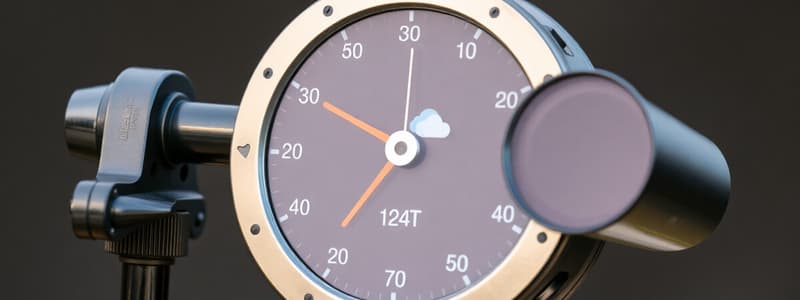Podcast
Questions and Answers
How does the intensity of precipitation relate to radar returns?
How does the intensity of precipitation relate to radar returns?
- Radar returns are not related to precipitation intensity.
- The color of radar returns indicates the type of precipitation, not the intensity.
- Weaker precipitation results in brighter radar returns.
- The brightness of the radar return echo is related to the amount of rain inside a cloud. (correct)
What is the fundamental principle driving weather patterns?
What is the fundamental principle driving weather patterns?
- Changes in the Earth's magnetic field affecting air density.
- Solar flares disrupting atmospheric conditions.
- The Earth's rotation influencing air currents.
- The atmosphere's tendency to equalize pressure imbalances. (correct)
Why is forecasting in the mid-latitudes considered especially challenging?
Why is forecasting in the mid-latitudes considered especially challenging?
- Computer models are less accurate for these areas.
- These regions experience more temperature variations than by the equator or at the poles. (correct)
- These regions experience less temperature variation than by the equator or at the poles.
- They lack sufficient weather monitoring infrastructure.
What is the primary function of the Storm Prediction Center (SPC)?
What is the primary function of the Storm Prediction Center (SPC)?
What do numerical weather prediction (NWP) models utilize to project atmospheric changes?
What do numerical weather prediction (NWP) models utilize to project atmospheric changes?
The fundamental purpose of weather forecasting is to:
The fundamental purpose of weather forecasting is to:
Why are accurate predictions of severe weather events particularly crucial?
Why are accurate predictions of severe weather events particularly crucial?
Which instrument is specifically designed to measure atmospheric pressure, a key determinant in weather forecasting?
Which instrument is specifically designed to measure atmospheric pressure, a key determinant in weather forecasting?
The interconnectedness of air pressure and temperature, as measured by a barometer and thermometer respectively, is significant for weather prediction because:
The interconnectedness of air pressure and temperature, as measured by a barometer and thermometer respectively, is significant for weather prediction because:
Prior to the widespread use of computer models, the primary method for weather forecasting relied on:
Prior to the widespread use of computer models, the primary method for weather forecasting relied on:
Flashcards
Weather Forecasting
Weather Forecasting
Predicting weather conditions using science and technology.
Weather
Weather
Instantaneous atmospheric state, including temperature, pressure, wind, and precipitation.
Thermometers
Thermometers
Measure air temperature outside.
Barometers
Barometers
Signup and view all the flashcards
Radiosondes
Radiosondes
Signup and view all the flashcards
Radar
Radar
Signup and view all the flashcards
Numerical Weather Prediction (NWP)
Numerical Weather Prediction (NWP)
Signup and view all the flashcards
Medium-Range Forecasts (MRF)
Medium-Range Forecasts (MRF)
Signup and view all the flashcards
Weather Warning
Weather Warning
Signup and view all the flashcards
Study Notes
- Weather forecasting uses tools, data, science, and technology to predict weather conditions in advance.
- Early weather forecasting relied on observation before the advent of computer models.
- The first computer-generated weather forecast was created in 1955.
- Weather forecasts inform daily life and long-term planning.
- Forecasting involves measuring temperature, pressure, precipitation, wind speed, and cloud cover, and sharing these readings.
- Weather forecasts help understand and prepare for the impact of weather on daily life.
- Severe weather forecasts are crucial for saving lives, property, and crops.
- Weather reports provide information on current atmospheric conditions, including temperature, pressure, wind speed, and precipitation.
- Weather forecasting aims to predict atmospheric conditions for the near future.
Weather Forecasting Tools
- Meteorologists use tools to measure and gather weather data.
- Tools for measuring current weather conditions include:
- Outdoor thermometers: air temperature
- Barometers: air pressure
- Anemometers: wind speed and direction
- Hygrometers: humidity
- Radar detects objects in the air, primarily precipitation.
- Radiosondes are balloon-borne instruments that gather precise atmospheric data during severe weather.
- Radiosondes measure and transmit pressure, temperature, and humidity to a ground station.
- Data from various instruments are fed into computer models to generate forecasts.
Barometers
- Barometers measure atmospheric pressure, which is the weight of air above a given level.
- Air pressure and temperature are related; warm air correlates with higher pressure, and cold air with lower pressure.
- Temperature differences create pressure differences, causing air to move from high to low-pressure areas.
- Air movement seeking balance creates weather.
Radar
- Radar (Radio Detection and Ranging) is a critical tool that emits microwave pulses.
- When the wave hits a target (rain, cloud, insect), part of it bounces back.
- The return is amplified and displayed, with brightness indicating rain intensity.
- Radar detects the location and intensity of precipitation and can aid in detecting tornadoes.
- Red and purple on radar indicate strong returns and intense precipitation.
Thermometers
- Thermometers measure air temperature.
- Liquid-in-glass thermometers, using mercury or red-dyed alcohol, are common for surface air temperature.
- When air warms, the liquid expands and rises in the tube.
- Temperature impacts water's state: below 32°F (0°C) water is solid, above it is liquid.
- Water evaporates/boils at 212°F (100°C).
- Water vapor holds heat, meaning Earth's surface temperature directly relates to water.
- The coldest temperature, -128.6°F (-89.2°C), was recorded in Antarctica in July 1983.
- The warmest temperature, 134.1°F (56.7°C), was recorded in Death Valley, California, in 1913.
Computer Models
- Computer models analyze incoming weather data to interpret patterns for short and long-range forecasts.
- Computer forecasting is called numerical weather prediction (NWP).
- NWP uses mathematical equations with variables like temperature, pressure, and moisture.
- Computers calculate how these variables change over time, typically for 12-48 hour periods.
- Weather forecasting uses probability, such as researching past snowfall occurrences on New Year's Eve in NYC.
- Mid-latitude forecasting is challenging due to temperature variations.
- Meteorologists use four classifications of weather forecasts: short-range, medium-range, long-range, and hazardous weather forecasts.
Types of Weather Forecasting
- Short-range forecasts predict weather 12-48 hours ahead.
- Medium-range forecasts (MRF) predict the atmosphere 132 hours ahead, or 3-7 days.
- Long-range forecasts are probability-based regarding temperature and precipitation (below, at, or above normal).
- These are given 8-14 days out, monthly, and seasonally.
- Hazardous weather forecasts are statements from the NOAA/NWS Storm Prediction Center (SPC) for severe weather within a seven-day window.
Examples of Hazardous Weather Forecasting
- The Storm Prediction Center (SPC) aims to provide data on tornadoes, severe thunderstorms, lightning, wildfires, and winter weather.
- Meteorologists monitor forecasts and data for potential severe weather.
- If conditions favor severe weather, a watch is issued, and local weather services, news, and EMS personnel are notified.
- A warning indicates imminent severe weather (tornado, thunderstorm, tsunami) and is issued upon visual confirmation or radar detection.
- Early detection via these forecasts enables preparation and seeking safe locations.
Studying That Suits You
Use AI to generate personalized quizzes and flashcards to suit your learning preferences.





